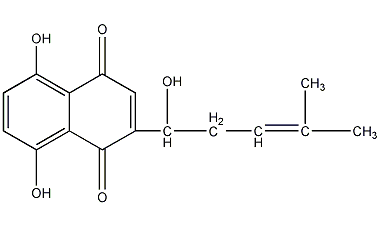
Structural formula
| Business number | 05C0 |
|---|---|
| Molecular formula | C16H16O5 |
| Molecular weight | 288.30 |
| label |
Shikonin, Shikonin, purple root pigment, comfrey, 5,8-Dihydroxy-2-[(1R)-1-hydroxy-4-methylpent-3-enyl]naphthalene-1,4-dione, 5,8-Dihydroxy-2-[(1R)-1-hydroxy-4-methyl-pent-3-enyl]naphthalene-1,4-dione, food coloring agent |
Numbering system
CAS number:517-89-5
MDL number:None
EINECS number:None
RTECS number:None
BRN number:None
PubChem ID:None
Physical property data
1. Properties: Purple-brown needle-like crystals
2. Density (g/ cm3, 25/4℃): Undetermined
3. Relative vapor density (g/cm3, air=1): Undetermined
4. Melting point (ºC): 147
5. Boiling point (ºC, normal pressure): Undetermined
6. Boiling point (ºC, 8kPa): Undetermined
7. Refractive index: Undetermined
8. Flash point (ºC): Undetermined
9. Specific rotation (º): +135 (benzene)
10. Autoignition point or ignition temperature (ºC): Undetermined
11. Vapor pressure (kPa, 25ºC): Undetermined
12. Saturated vapor pressure (kPa, 60ºC): Undetermined
13. Heat of combustion (KJ/mol): Undetermined
14. Critical temperature (ºC): Undetermined
15. Critical pressure (KPa): Undetermined
16 . The logarithmic value of the oil-water (octanol/water) partition coefficient: Undetermined
17. Explosion upper limit (%, V/V): Undetermined
18. Explosion lower limit (% ,V/V): Undetermined
19. Solubility: Soluble in phenylethyl ether, acetone, chloroform, methanol, ethanol, glycerin, animal and vegetable oils and alkaline aqueous solutions, soluble in water.
Toxicological data
1. Acute toxicity: Mouse oral LC50: >1gm/kg, no detailed description except lethal dose;
Mouse intraperitoneal LC50: 20mg/kg, changes body activity, synergy Disorders;
Rabbit intravenous LD50: 16mg/kg, no details except lethal dose;
Ecological data
This substance may be harmful to the environment, and special attention should be paid to water bodies.
Molecular structure data
1. Molar refractive index: 75.86
2. Molar volume (cm3/mol): 209.9
3. Isotonic specific volume (90.2K): 596.5
4. Surface tension (dyne/cm): 65.1
5. Polarizability (10-24cm3): 30.07
Compute chemical data
1. Reference value for hydrophobic parameter calculation (XlogP): 3
2. Number of hydrogen bond donors: 3
3. Number of hydrogen bond acceptors: 5
4. Number of rotatable chemical bonds: 3
5. Number of tautomers: 15
6. Topological molecule polar surface area 94.8
7. Number of heavy atoms: 21
8. Surface charge: 0
9. Complexity: 501
10. Number of isotope atoms: 0
11. Determine the number of atomic stereocenters: 1
12. Uncertain number of atomic stereocenters: 0
13. Determine the number of chemical bond stereocenters: 0
14. Number of uncertain chemical bond stereocenters: 0
15. Number of covalent bond units: 1
Properties and stability
1. Use and store according to specifications. It will not decompose and avoid contact with oxides
2. The color changes with the pH value. The pH value of 4~6 is red, the pH value of 8 is purple, and the pH value of 10~12 is blue. color. It has good light resistance, heat resistance and oxidation resistance, is unstable to reducing dose, and turns dark purple when exposed to iron ions. It has certain antibacterial effect.
Storage method
1. Store in a cool, dry and well-ventilated warehouse. Keep away from fire and heat sources. Protect from direct sunlight. The packaging is sealed. They should be stored separately from acids and food chemicals, and avoid mixed storage. Suitable materials should be available in the storage area to contain spills.
Synthesis method
1. Use the roots of Lithospermum sinensis as raw material, extract it with 4 times the amount (mass) of refined soybean oil at 165-170°C for 6 minutes, and then separate it with 95% ethanol (volume ratio) slightly more than the soybean oil. Extract the extract twice; concentrate the ethanol extract under a vacuum of 80kPa, and then filter out the insoluble matter to obtain the finished product.
2.Lithospermum root is extracted with ethanol, propylene glycol, edible oil, water, etc. Our country has been used in dyes and pharmaceuticals since ancient times (it has antipyretic and detoxifying effects).
Purpose
1. As a food coloring agent, our country stipulates that it can be used in fruit juice (flavored) beverages, fruit wine, ice cream and popsicles, with a maximum usage of 0.1g/kg.
2.Used for cosmetic coloring.



